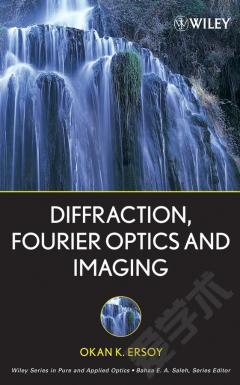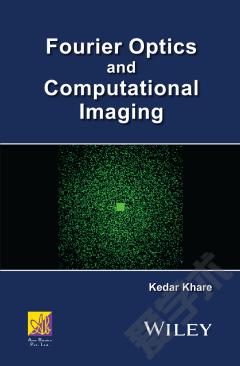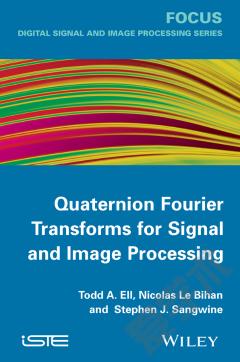Diffraction, Fourier Optics and Imaging
Preface. 1. Diffraction, Fourier Optics and Imaging. 1.1 Introduction. 1.2 Examples of Emerging Applications with Growing Significance. 2. Linear Systems and Transforms. 2.1 Introduction. 2.2 Linear Systems and Shift Invariance. 2.3 Continuous-Space Fourier Transform. 2.4 Existence of Fourier Transform. 2.5 Properties of the Fourier Transform. 2.6 Real Fourier Transform. 2.7 Amplitude and Phase Spectra. 2.8 Hankel Transforms. 3. Fundamentals of Wave Propagation. 3.1 Introduction. 3.2 Waves. 3.3 Electromagnetic Waves. 3.4 Phasor Representation. 3.5 Wave Equations in a Charge-Free Medium. 3.6 Wave Equations in Phasor Representation in a Charge-Free Medium. 3.7 Plane EM Waves. 4. Scalar Diffraction Theory. 4.1 Introduction. 4.2 Helmholtz Equation. 4.3 Angular Spectrum of Plane Waves. 4.4 Fast Fourier Transform (FFT) Implementation of the Angular Spectrum of Plane Waves. 4.5 The Kirchoff Theory of Diffraction. 4.6 The Rayleigh-Sommerfeld Theory of Diffraction. 4.7 Another Derivation of the First Rayleigh-Sommerfeld Diffraction Integral. 4.8 The Rayleigh-Sommerfeld Diffraction Integral For Nonmonochromatic Waves. 5. Fresnel and Fraunhofer Approximations. 5.1 Introduction. 5.2 Diffraction in the Fresnel Region. 5.3 FFT Implementation of Fresnel Diffraction. 5.4 Paraxial Wave Equation. 5.5 Diffraction in the Fraunhofer Region. 5.6 Diffraction Gratings. 5.7 Fraunhofer Diffraction By a Sinusoidal Amplitude Grating. 5.8 Fresnel Diffraction By a Sinusoidal Amplitude Grating. 5.9 Fraunhofer Diffraction with a Sinusoidal Phase Grating. 5.10 Diffraction Gratings Made of Slits. 6. Inverse Diffraction. 6.1 Introduction. 6.2 Inversion of the Fresnel and Fraunhofer Representations. 6.3 Inversion of the Angular Spectrum Representation. 6.4 Analysis. 7. Wide-Angle Near and Far Field Approximations for Scalar Diffraction. 7.1 Introduction. 7.2 A Review of Fresnel and Fraunhofer Approximations. 7.3 The Radial Set of Approximations. 7.4 Higher Order Improvements and Analysis. 7.5 Inverse Diffraction and Iterative Optimization. 7.6 Numerical Examples. 7.7 More Accurate Approximations. 7.8 Conclusions. 8. Geometrical Optics. 8.1 Introduction. 8.2 Propagation of Rays. 8.3 The Ray Equations. 8.4 The Eikonal Equation. 8.5 Local Spatial Frequencies and Rays. 8.6 Matrix Representation of Meridional Rays. 8.7 Thick Lenses. 8.8 Entrance and Exit Pupils of an Optical System. 9. Fourier Transforms and Imaging with Coherent Optical Systems. 9.1 Introduction. 9.2 Phase Transformation With a Thin Lens. 9.3 Fourier Transforms With Lenses. 9.4 Image Formation As 2-D Linear Filtering. 9.5 Phase Contrast Microscopy. 9.6 Scanning Confocal Microscopy. 9.7 Operator Algebra for Complex Optical Systems. 10. Imaging with Quasi-Monochromatic Waves. 10.1 Introduction. 10.2 Hilbert Transform. 10.3 Analytic Signal. 10.4 Analytic Signal Representation of a Nonmonochromatic Wave Field. 10.5 Quasi-Monochromatic, Coherent, and Incoherent Waves. 10.6 Diffraction Effects in a General Imaging System. 10.7 Imaging With Quasi-Monochromatic Waves. 10.8 Frequency Response of a Diffraction-Limited Imaging System. 10.9 Computer Computation of the Optical Transfer Function. 10.10 Aberrations. 11. Optical Devices Based on Wave Modulation. 11.1 Introduction. 11.2 Photographic Films and Plates. 11.3 Transmittance of Light by Film. 11.4 Modulation Transfer Function. 11.5 Bleaching. 11.6 Diffractive Optics, Binary Optics, and Digital Optics. 11.7 E-Beam Lithography. 12. Wave Propagation in Inhomogeneous Media. 12.1 Introduction. 12.4 Beam Propagation Method. 12.5 Wave Propagation in a Directional Coupler. 13. Holography. 13.1 Introduction. 13.2 Coherent Wave Front Recording. 13.3 Types of Holograms. 13.4 Computer Simulation of Holographic Reconstruction. 13.5 Analysis of Holographic Imaging and Magnification. 13.6 Aberrations. 14. Apodization, Superresolution, and Recovery of Missing Information. 14.1 Introduction. 14.2 Apodization. 14.2.1 Discrete-Time Windows. 14.3 Two-Point Resolution and Recovery of Signals. 14.4 Contractions. 14.5 An Iterative Method of Contractions for Signal Recovery. 14.6 Iterative Constrained Deconvolution. 14.7 Method of Projections. 14.8 Method of Projections onto Convex Sets. 14.9 Gerchberg-Papoulis (GP) Algorithm. 14.10 Other POCS Algorithms. 14.11 Restoration From Phase. 14.12 Reconstruction From a Discretized Phase Function by Using the DFT. 14.13 Generalized Projections. 14.14 Restoration From Magnitude. 14.15 Image Recovery By Least Squares and the Generalized Inverse. 14.16 Computation of Hp By Singular Value Decomposition (SVD). 14.17 The Steepest Descent Algorithm. 14.18 The Conjugate Gradient Method. 15. Diffractive Optics I. 15.1 Introduction. 15.2 Lohmann Method. 15.3 Approximations in the Lohmann Method. 15.4 Constant Amplitude Lohmann Method. 15.5 Quantized Lohmann Method. 15.6 Computer Simulations with the Lohmann Method. 15.7 A Fourier Method Based on Hard-Clipping. 15.8 A Simple Algorithm for Construction of 3-D Point Images. 15.9 The Fast Weighted Zero-Crossing Algorithm. 15.10 One-Image-Only Holography. 15.11 Fresnel Zone Plates. 16. Diffractive Optics II. 16.1 Introduction. 16.2 Virtual Holography. 16.3 The Method of POCS for the Design of Binary DOE. 16.4 Iterative Interlacing Technique (IIT). 16.5 Optimal Decimation-in-Frequency Iterative Interlacing Technique (ODIFIIT). 16.5.1 Experiments with ODIFIIT. 16.6 Combined Lohmann-ODIFIIT Method. 17. Computerized Imaging Techniques I: Synthetic Aperture Radar. 17.1 Introduction. 17.2 Synthetic Aperture Radar. 17.3 Range Resolution. 17.4 Choice of Pulse Waveform. 17.5 The Matched Filter. 17.6 Pulse Compression by Matched Filtering. 17.7 Cross-Range Resolution. 17.8 A Simplified Theory of SAR Imaging. 17.9 Image Reconstruction with Fresnel Approximation. 17.10 Algorithms for Digital Image Reconstruction. 18. Computerized Imaging II: Image Reconstruction from Projections. 18.1 Introduction. 18.2 The Radon Transform. 18.3 The Projection Slice Theorem. 18.4 The Inverse Radon Transform. 18.5 Properties of the Radon Transform. 18.6 Reconstruction of a Signal From its Projections. 18.7 The Fourier Reconstruction Method. 18.8 The Filtered-Backprojection Algorithm. 19. Dense Wavelength Division Multiplexing. 19.1 Introduction. 19.2 Array Waveguide Grating. 19.3 Method of Irregularly Sampled Zero-Crossings (MISZC). 19.4 Analysis of MISZC. 19.4.1 Dispersion Analysis. 19.4.2 Finite-Sized Apertures. 19.5 Computer Experiments. 19.6 Implementational Issues. 20. Numerical Methods for Rigorous Diffraction Theory. 20.1 Introduction. 20.2 BPM Based on Finite Differences. 20.3 Wide Angle BPM. 20.4 Finite Differences. 20.5 Finite Difference Time Domain Method. 20.6 Computer Experiments. 20.7 Fourier Modal Methods. Appendix A: The Impulse Function. Appendix B: Linear Vector Spaces. Appendix C: The Discrete-Time Fourier Transform, The Discrete Fourier Transform and The Fast Fourier Transform. References. Index.
{{comment.content}}








 京公网安备 11010802027623号
京公网安备 11010802027623号